When to Use C vs. K: Teaching Info + Free Printables
This post may contain affiliate links. As an Amazon affiliate, we earn from qualifying purchases. See our disclosure policy.
Learn the spelling generalizations for the /k/ sound and when to use C vs. K! Teaching this rule will be easy with the information and FREE printable resources! Download our helpful anchor chart and a practice worksheet to help your students become proficient spellers with C and K.
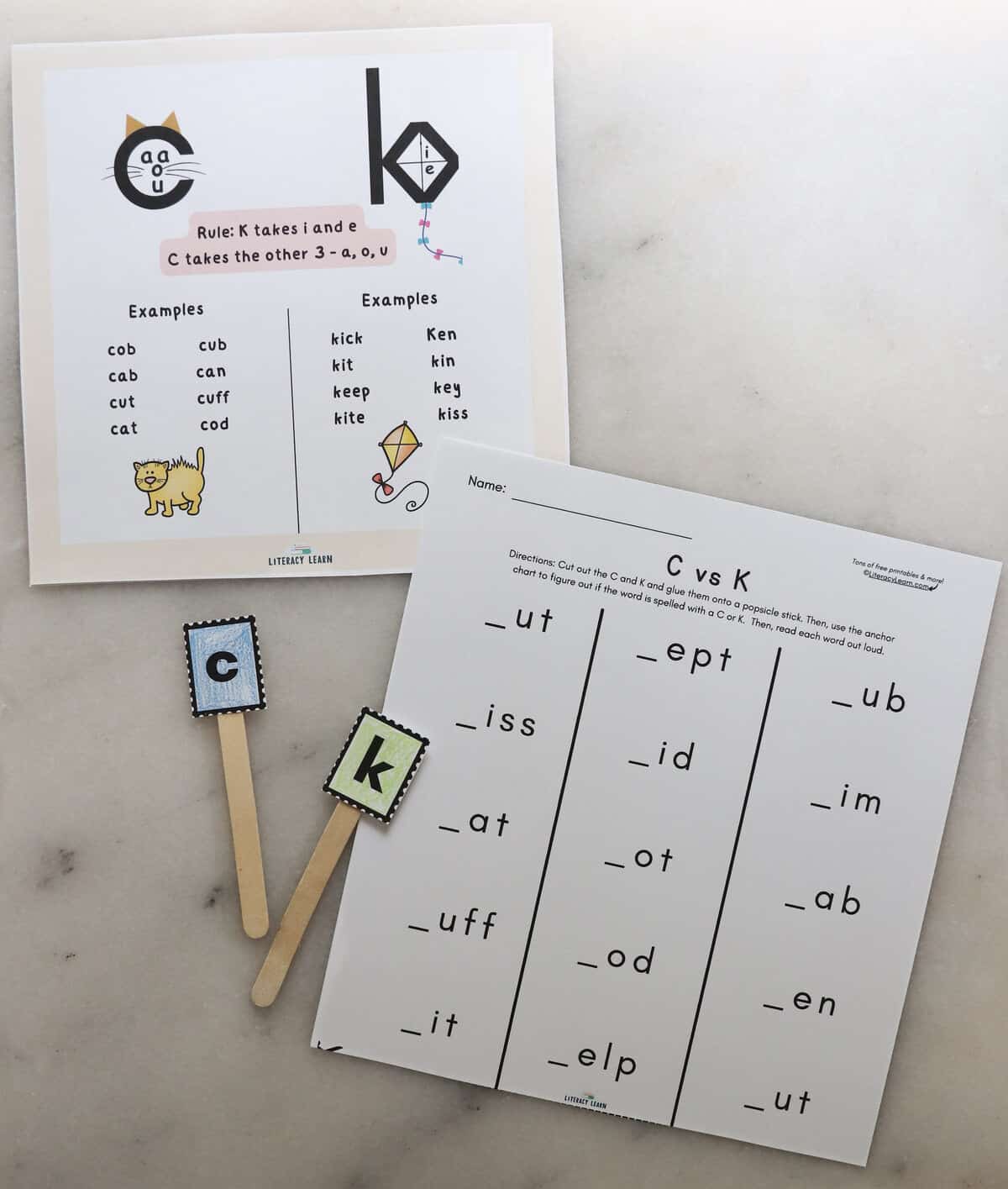
Beginning /K/ Sound Rule for C or K
When kids hear a /k/ sound at the beginning of a word, do they know which spelling to use? Is it C or K? Thankfully, they don’t have to just take a wild guess.
Two separate studies found that letter-sound knowledge, combined with simple rules about how letters interact with one another, can eliminate confusion for students.
The findings tell us that once students have the letter-sound knowledge that C says /k/ and K says /k/, they are ready to learn this rule about how the letters C and K at the beginning of words interact with others.
We call this a spelling generalization (or rule). And the C vs. K rule is a really fun one!
The C vs. K Spelling Rule:
🐈 Use C when it is followed by the letters a, o, & u.
🪁 Use K when it is followed by the vowels e & i.
It’s sometimes referred to as a Cat-Kite Rule or the Kitty Cat Rule.
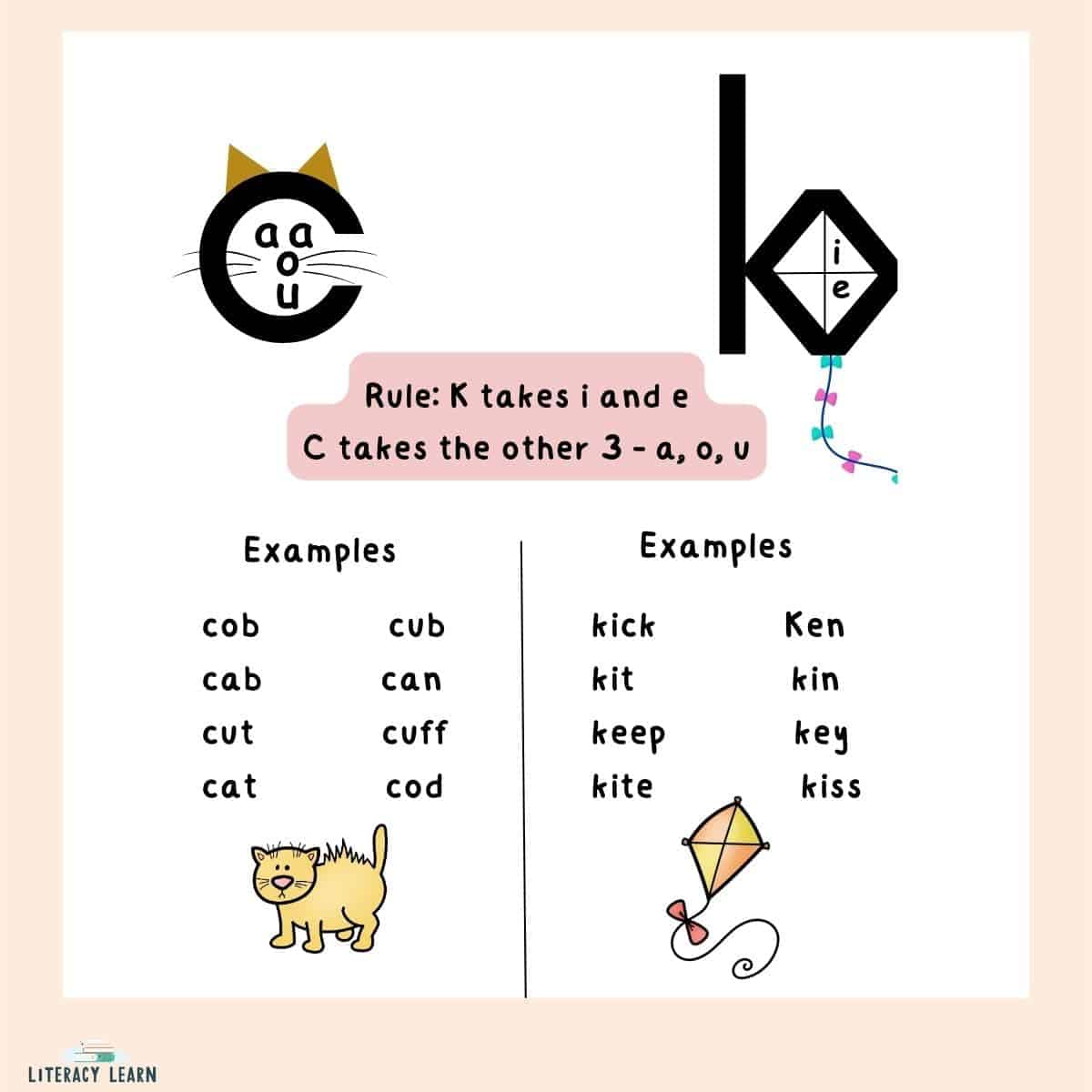
Examples of /k/ words that start with c:
- cat
- cab
- cod
- cub
- can
- cut
- cuff
Examples of /k/ words that start with k:
- kite
- kit
- kick
- keep
- kiss
- key
- kin
- Ken
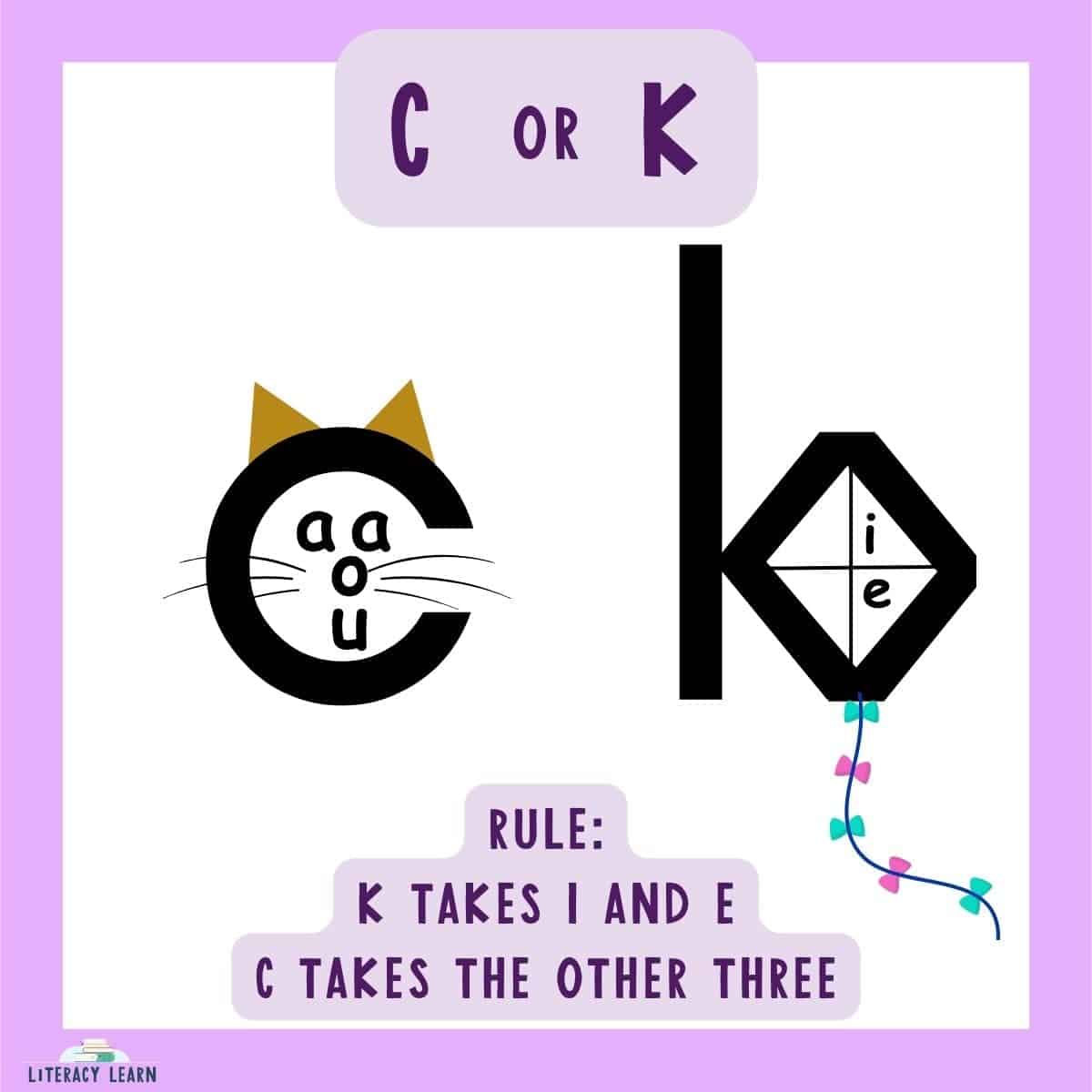
Teaching the C vs. K Rule
🎶 In my various Orton-Gillingham trainings, I’ve learned about two catchy rhymes you can use with your students to help them remember the rule. You can use either or both with your students:
- K takes i and e. C takes the other 3.
- C goes with A, O, and U. K goes with the other 2.
Kids need to listen for the short vowel sound that comes directly after the /k/ sound to determine which letter to use.
Of course, kids need to know all five vowels in order to learn these rules. Then, they need practice, practice, practice!
We want to make teaching easy, so we’re giving away two freebies for your students to practice! Kids can master this concept quickly using our resources.
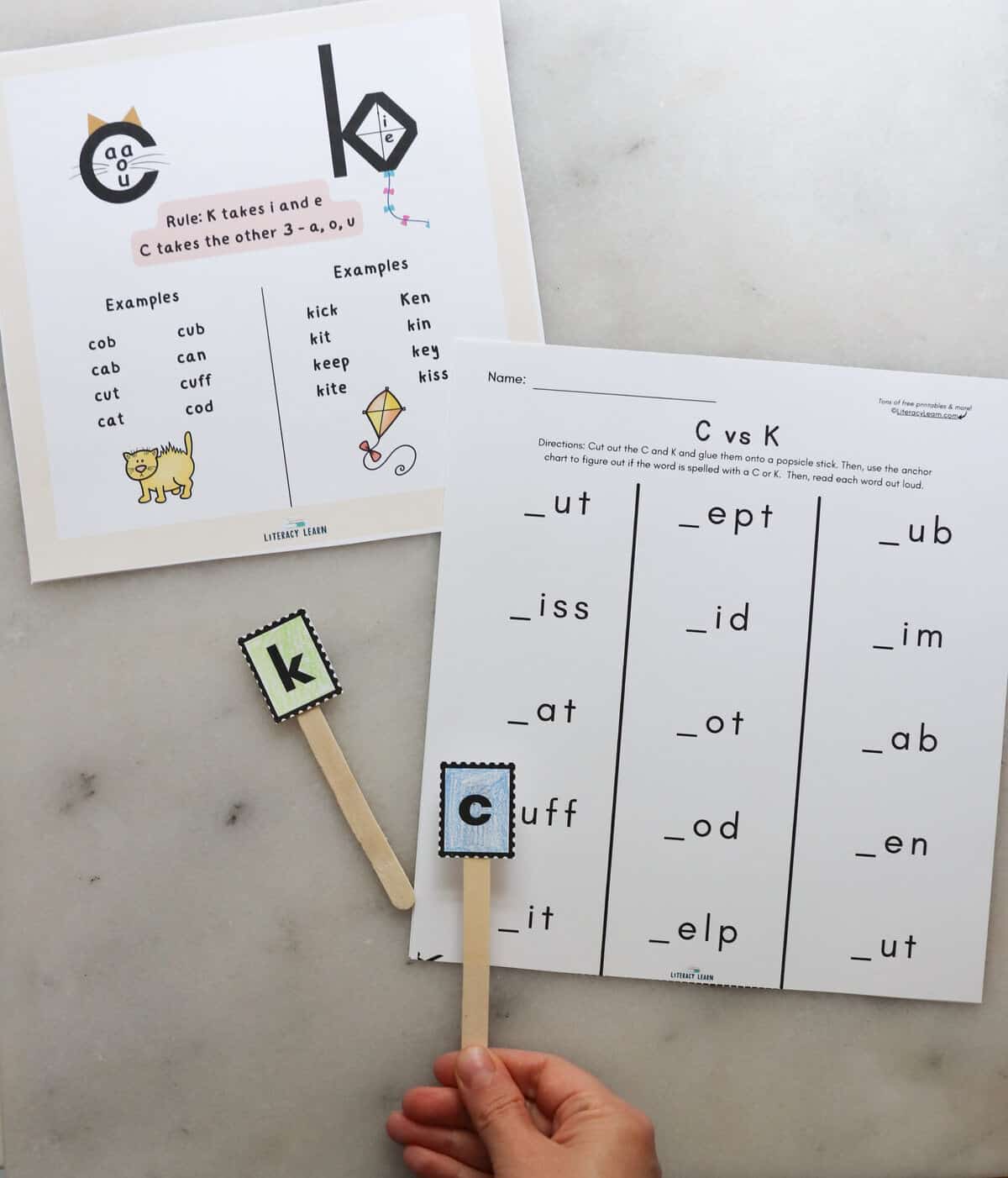
C vs. K Anchor Chart
This anchor chart has the letters C and K, but disguised as a Cat or Kite. Within the letter, you see the vowels each consonant takes. This is an easy to remember visual to help students remember the rule.
After initially teaching the rule, display the chart in your classroom for kids to reference. You can also print individual copies for kids to place in their phonics notebooks!
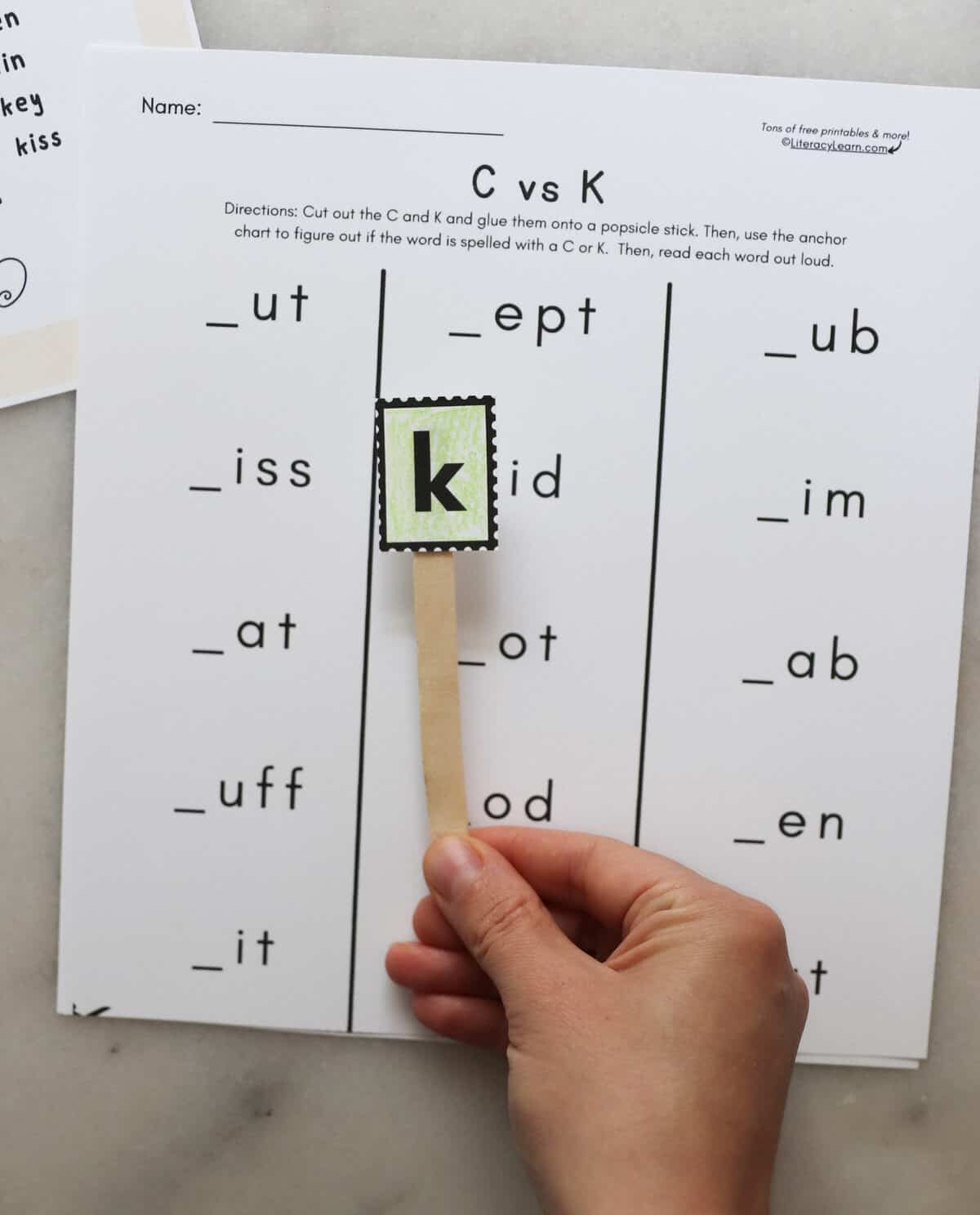
C vs. K Worksheet
This beginning letter worksheet is perfect for fun, multisensory practice.
Kids will cut out the C and K stamps at the bottom of the page and glue them to a popsicle stick, straw, or even a pencil. Then, they look at the word to determine whether it’s spelled with a C or K.
👀 This worksheet forces kids to look at the vowel and apply the rule they’ve been taught. It’s perfect as a scaffold for mastering this spelling concept!
Teaching Ideas for C vs. K
Here are some tips and teaching strategies to reinforce this spelling generalization:
- Rule Introduction: Begin with explicit instruction. Explain the rule to your students, emphasizing the different scenarios when C or K is used for the /k/ sound. Use visuals, anchor charts, and fun examples to aid comprehension.
- Video: Show your students this amazing Cat/Kite Rule video to get kids excited about this rule!
- Word Sorts: Word sorts are great to promote visual memory and visual discrimination. Provide your students with a variety of words and have them sort them based on whether they should use C or K to spell the /k/ sound. Engage them in discussions about the rule and the patterns they notice.
- Dictation: Word and sentence dictation are essential components to see if students can apply the rule. For the ultimate word list, grab our Ultimate Word List TPT product with over 2000+ words organized by phonics skills.
- Reading and Writing: Incorporate reading passages, decodables, and writing assignments that contain words with the /k/ sound.
Important Tips
When to Teach C vs. K: You can teach this rule in kindergarten and review it again in first grade. Be sure your students have been taught letters C, K, the five short vowels, and can blend CVC patterns to read and spell words.
If you have older students still struggling with spelling, teach them these additional rules:
- Use the letter K when the /k/ sound is followed by the letter Y like in the word Kyle or kyack.
- Use the letter C when the /k/ sound is followed by a consonant. This will help them spell with consonant blends like ‘class’ or ‘crest.’
Did you know? 🤔 This rule is the precursor to the Gentle Cindy rule. The Gentle Cindy rule states that when the letter C is followed by an e, i, or y, it makes the C say the /s/ sound. Learn more about the Soft C sound and get some free resources to help teach it!
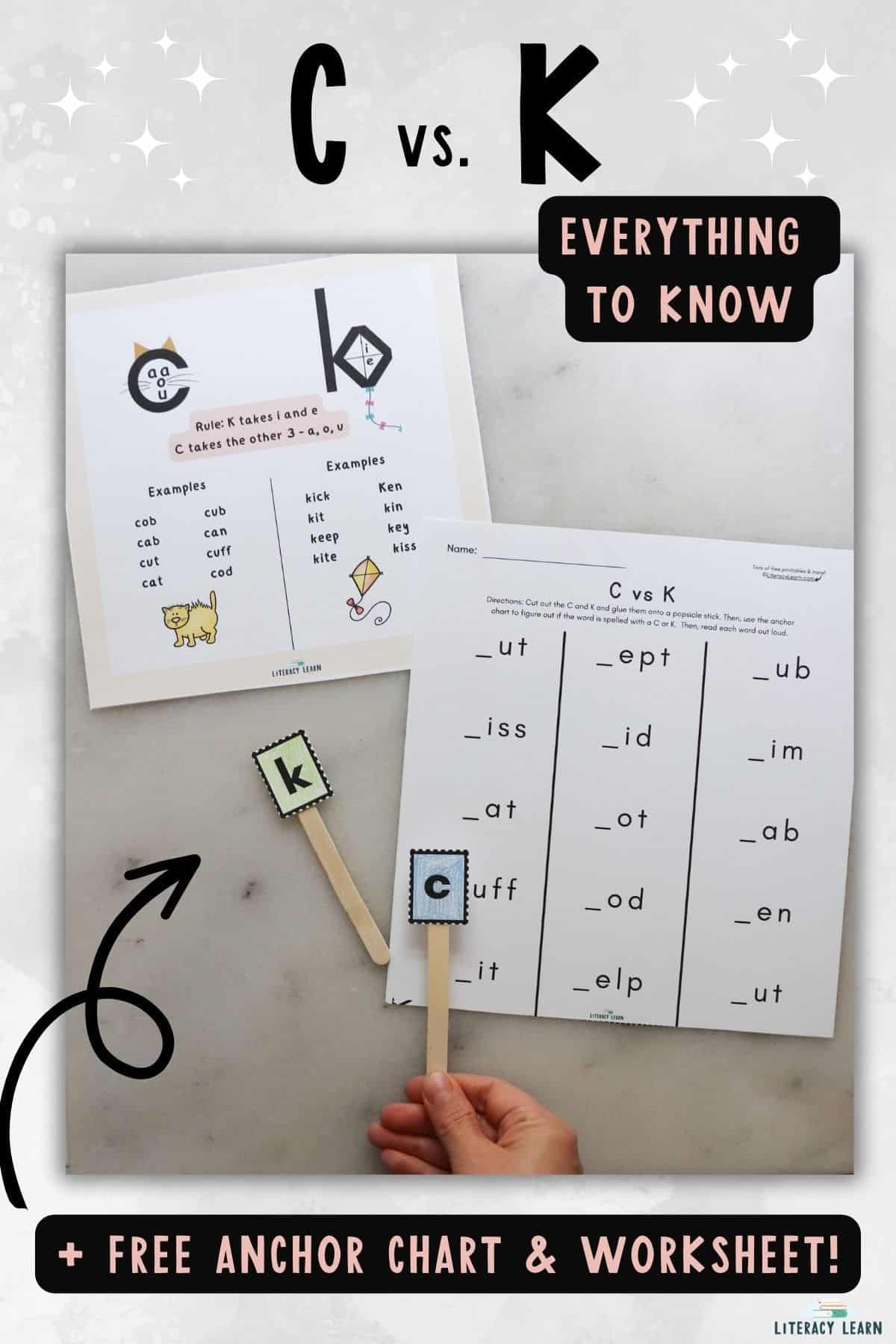
🖨 Download & Print
We’d love to hear about your experience using this resource and value your feedback!
Please leave a comment below or tag us on Instagram @literacylearn.
DOWNLOAD TERMS: All of our resources and printables are designed for personal use only in homes and classrooms. Each teacher must download his or her own copy. To share with others, please use the social share links provided or distribute the link to the blog post so others can download their own copies. Please do not save our files to a shared drive, reproduce our resources on the web, or make photocopies for anyone besides your own students. Your support in this allows us to keep making free resources for everyone! Please see our Creative Credits page for information about the licensed clipart we use. If you have any questions or concerns regarding our terms, please email us. Thank you!

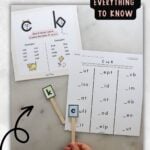
Thanks!
You’re welcome!
I put this up in my room (I’m a literacy tutor), and referenced it to a second grader I’m working with. He totally got it, and is now spelling words correctly! He spelled “skill” on the first try, and when I asked him how he knew to use K instead of C, he pointed to the poster! I was so impressed! We were focusing on suffixes, so he had to access previously taught information (bonus letters, C vs K, and blends) to get the baseboard correct. And he did it! Totally because of your poster! Thanks!
Treva,
We LOVE hearing success stories like this! You student must be so proud of himself. (I was in my 30’s before I knew there was a rule for which spelling to use.)
-Katie
I love all your free resources!!! As I’m only a .3 academic intervention teacher this helps me best to meet my student’s needs!! You girls are the best!!! Many thanks for all you do to support teachers!!! Risa
Hi Risa,
We are SO glad we can support you and your students 🙂 We are grateful for your kind feedback!
Katie and Laura
What a valuable resource for writing too!! Kids often don’t know whether to use a c or a K. l love the kitty cat rule!!
Yvette,
Yes! This rule is so helpful, especially when spelling words with the /k/ sound at the beginning. We are so glad you like this resource.
Katie and Laura
I love this and appreciate you sharing it. However, so many ads are popping up and “blinking” at me that it’s hard to focus on your blog content.
Chris,
We’re so glad you like this resource. We are so sorry the ads on this post were distracting. Our goal is to provide FREE resources on our website, and the adds help us keep the website running. We hope you understand and keep coming back for free resources.
Thanks for your feedback!
Katie and Laura